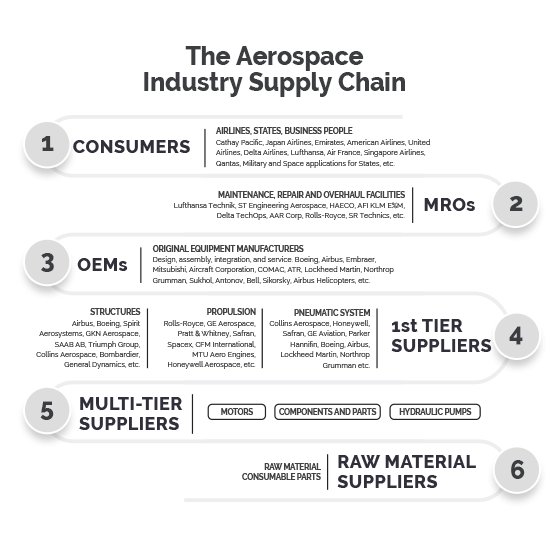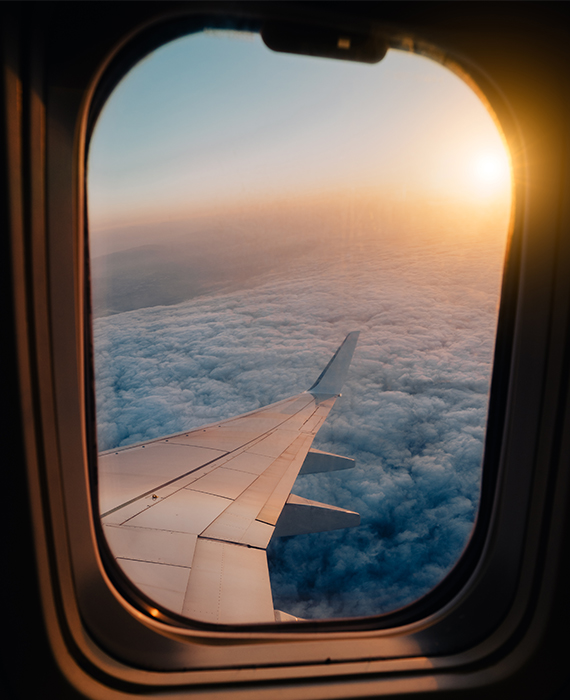
Support Providers
of Aerospace
Registered Courses
We are committed to delivering great service and truly appreciate hearing from our users.
Introduction
Overview of the Aerospace Industry

Overview of the aerospace industry
1. The Aerospace Industry supply chain
- Consumers - Airlines, States, Business People
- MROs Maintenance, Repair and Overhaul Facilities
- OEMs Original Equipment Manufacturers
- 1st TIER Suppliers
- Multi-TIER Suppliers
- Raw Material Suppliers

Overview of the aerospace industry
2. The IAQG
The Aerospace industry has established the International Aerospace Quality Group (IAQG) to implement initiatives to improve overall quality and reduce costs in the Aerospace supply chain.
The IAQG establishes quality standards for the aerospace supply chain with the collaboration of member organizations within the aviation, space, and defense that design, develop, manufacture, and support original equipment at all system and sub-system levels. The quality standards are published and applicable worldwide by all organizations within the aerospace industry.
The IAQG is divided into three sectors worldwide:
- AAQG: Americas Aerospace Quality Group
- EAQG: European Aerospace Quality Group
- APAQG: Asia Pacific Aerospace Quality Group

Overview of the aerospace industry
3. SAE International
The Society of Automotive Engineers is a non-profit organization which includes more than 200,000 engineers and experts in different industries such as aerospace, automotive, and commercial vehicles.
SAE International develops standards and academic solutions:
- 880 standards
- 4,000 technical publications
- 272 courses
- 76,500 students
- 1,800 investigations
- 23 countries
Overview of the aerospace industry
4. Aerospace standards
Aerospace standards include equipment management, airport safety, avoid counterfeit parts, and more. These standards ensure the highest safety and productivity levels for astronautic, military, and aerospace applications.
AS9100 Standard
applies to organizations that design, develop, and/or manufacture products and services for commercial, aviation and military and space applications. This standard includes all ISO9001 requirements plus the specific design and/or manufacturing requirements for aviation, space, and defense.
AS9110 Standard
applies to organizations that provide maintenance and/or airworthiness services applicable to commercial and military aircraft and engines. This standard includes all ISO9001 requirements plus the specific maintenance requirements for aviation, space, and defense.
AS9120 Standards
applies to organizations that acquire parts, materials, and assemblies and resell these products to aviation, space, and defense customers including organizations that acquire products and split them into small quantities. This standard includes all ISO9001 requirements plus the specific distribution requirements for aviation, space, and defense.
Overview of the aerospace industry
5. Certification process
The IAQG has established the Industry Controlled Other Party (ICOP) scheme to certify Quality Management Systems (QMS) of Aerospace Organizations. The ICOP scheme is described within the AS9104 standards:
Design and/or manufacturing organizations that manufacture, assemble, or provide services to aerospace customers shall be certified according to the requirements of AS9100 standards and following the ICOP scheme.
There are more than 26,000 organizations that are certified according to the AS9100 standard worldwide. More than 10,000 of these certified organizations are in the USA.
The Online Aerospace Supplier Information System (OASIS) website is managed by the IAQG and used to control Aerospace QMS certifications, 3rd party auditors, and 3rd party audits.
AS9104/1
Requirements for aviation, space, and defense QMS certification programs.
AS9104/2
Requirements for oversight of AQMS registration/certification programs.
AS9104/3
Requirements for aerospace auditor competency and training courses.

Overview of the aerospace industry
ICOP
Certification Scheme
Initial certification process
Re-certification Process
EVERY 3 YEARS